|
|
|
|
|
|
| ADVERTORIAL |
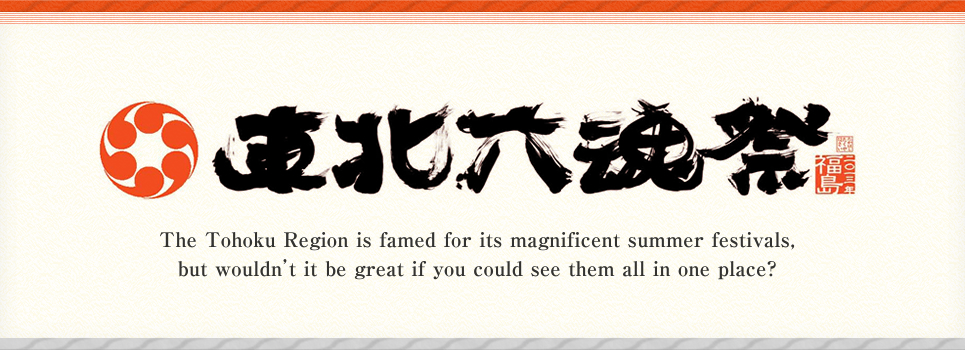
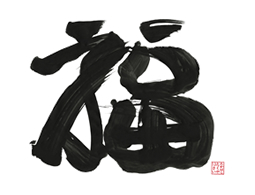 This year's festival theme is "fuku," or good fortune.
This year's festival theme is "fuku," or good fortune.
You can at the Tohoku Rokkonsai, a festival held in a different Tohoku city each year. Fukushima City is this year's host. Head there June 1-2 to see parades, floats and stage events featuring dancers, musicians and other performers.
Fukushima is one of the areas that sustained heavy damage in the Great East Japan Earthquake of March 2011, particularly from the tsunami it spawned. So the Tohoku Rokkonsai, created in 2011 to improve the region's spirits after the disaster, adopted a theme of "good fortune" this year, setting a positive tone as the region looks forward to a better future. An old Japanese proverb sums up this do-it-yourself, forward-thinking attitude: "Turn disaster into fortune."
Fears over the accident at the nearby nuclear power plant have deterred tourists, whom the Rokkonsai organizers want to lure back. They hope to harness the collective spiritual power gathered in Fukushima to get the Tohoku Region back on its feet.
The inaugural festival, held just months after the earthquake in Sendai City, adopted "prayer" as its theme, seeking a restful peace for the unfortunate disaster victims and the region's reconstruction. Initial expectations of 100,000 visitors were blown away by the 370,000 people who descended on Sendai.
Last year's Tohoku Rokkonsai was in Morioka City, Iwate Prefecture, where the theme was "hope," a demonstration of the Tohoku people's determination to rebuild their communities. The main stage featured festival performances and live musical acts by popular artists. The parade, of course, was one of the major events. While most performances consisted of folk entertainment, Shimajiro the tiger, a popular children's cartoon character, danced with festival-goers during an intermission. There were cold drinks and tasty snacks on sale, along with a Japanese-style "stamp rally" for kids to collect ink stamps.
The main event is the parade of floats, dancers, musicians and other performers from the six major participating festivals. This year's parade, which you can see June 1-2, will proceed down National Route 4 in Fukushima.
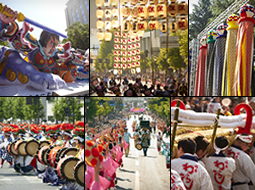
The parade features entries from each of the six regional festivals.
Twelve cities from throughout Fukushima Prefecture will put on stage shows, mainly consisting of demonstrations of their local festival performances. They're fun for the whole family. Visitors can also learn about the six festivals and twelve cities at information booths and buy such local specialties such as foods and handicrafts from all the cities at various stalls.
Twelve cities from Fukushima Prefecture will demonstrate performances from their local festivals in on-stage events:
 Clockwise from top left: Aizuwakamatsu – Aizu Higan Shishimai (Lion Dance); Date (pronounced "DAH-tay") – Reizan Daiko Matsuri (Drum Festival); Iwaki – Jangara Nenbutsu Odori (Buddhist Dance); Kitakata – Kuranomachi Kitakata Natsu Matsuri (Summer Festival); Koriyama – Ongaku Toshi Koriyama (Music Festival); Minamisoma – Soma Nagareyama Odori (Traditional Dance)
Clockwise from top left: Aizuwakamatsu – Aizu Higan Shishimai (Lion Dance); Date (pronounced "DAH-tay") – Reizan Daiko Matsuri (Drum Festival); Iwaki – Jangara Nenbutsu Odori (Buddhist Dance); Kitakata – Kuranomachi Kitakata Natsu Matsuri (Summer Festival); Koriyama – Ongaku Toshi Koriyama (Music Festival); Minamisoma – Soma Nagareyama Odori (Traditional Dance)
 Clockwise from top left: Motomiya – Adatara Daiko (Drum Festival); Nihonmatsu – Nihonmatsu no Chochin Atsumari (Lantern Festival); Shirakawa – Anchin Nenbutsu Odori (Buddhist Dance at Anchin-do Temple); Soma – Soma Minyo (Folk Song Festival); Sukagawa – Taimatsu Taiko (Drum Festival); Tamura – Onigoro Hatagoro Daiko (Demon Legend Festival)
Clockwise from top left: Motomiya – Adatara Daiko (Drum Festival); Nihonmatsu – Nihonmatsu no Chochin Atsumari (Lantern Festival); Shirakawa – Anchin Nenbutsu Odori (Buddhist Dance at Anchin-do Temple); Soma – Soma Minyo (Folk Song Festival); Sukagawa – Taimatsu Taiko (Drum Festival); Tamura – Onigoro Hatagoro Daiko (Demon Legend Festival)
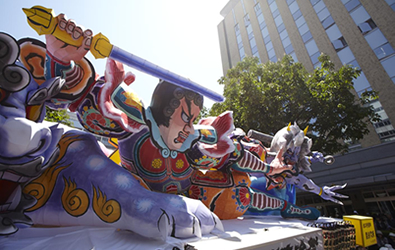
Aomori Nebuta Festival
An incarnation of the Japanese-style Tanabata "Star Festival," the Nebuta Festival in Aomori City is one of the Three Great Festivals of the Tohoku region. The main draw is the large floats made from washi paper. Essentially giant paper lanterns, they can be up to 9 meters wide and 5 meters tall. Carried by hand, the floats are accompanied by dancers and musicians, who encourage audience participation. The floats are paraded over several nights and on the afternoon of the final day, after which some are floated in Aomori's bay. Spectators are then treated to a two-hour firework display.
Aug. 2-7. http://www.atca.info/nebuta_en/
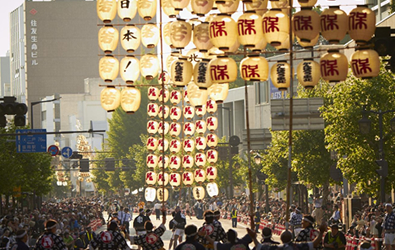
Akita Kanto Festival
One of the Three Great Festivals, the Kanto Festival in Akita City stands out for the parade of performers carrying long bamboo poles called kanto. Dozens of paper lanterns are hung on the poles. The carriers balance the ends on their hands shoulders, waists Eeven their foreheads and necks! Of course they are accompanied by music, featuring taiko drums, flutes and chanting.
Aug. 3-6. http://www.kantou.gr.jp/english/
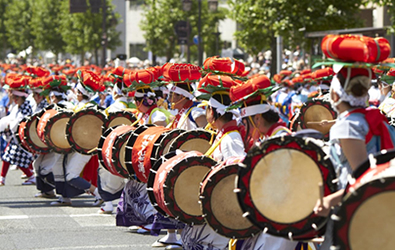
Morioka Sansa Odori
Morioka City's summer festival is said to originate from an episode long ago, when the people were terrorized by an evil demon named Rasetsu. The deity Mitsuishi-kami heard their prayers, and he drove Rasetsu away forever, causing the grateful people to dance and chant in celebration, as they do today in the Sansa Odori. The festival boasts the world's biggest taiko drum parade, certified by Guinness World Records. Dance instructors call out to spectators for an on-the-spot dance lesson.
Aug. 1-4. http://www.sansaodori.jp/pdf/pamphlet_english.pdf (pdf file)
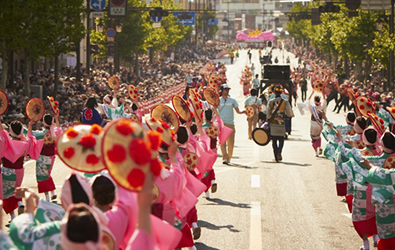
Yamagata Hanagasa Festival
This festival's parade brings to Yamagata City taiko drums, beautiful floats and over 10,000 dancers in flowered costumes. More than a million people come each year to witness the variety of stunningly choreographed dancing. Spectators are encouraged to jump in and participate.
Aug. 5-7. http://www.hanagasa.jp/en/
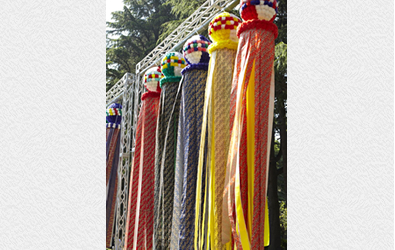
Sendai Tanabata Festival
One of the Three Great Festivals, Sendai City's summer festival draws over 2 million people annually and features thousands of giant colorful streamers that decorate the city. The streamers, representing the threads of a loom, are made by local shops, schools and community groups from washi paper and bamboo.
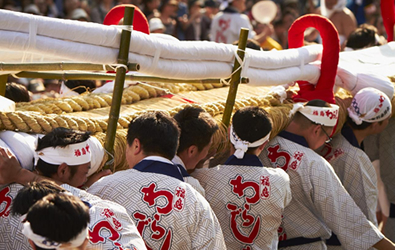
Fukushima Waraji Festival
Participants in Fukushima City's festival parade carry Japan's largest waraji, or straw sandals, to Ashio Shrine for dedication and to pray for strong legs. The parade also features the Dancing Soda Night hip hop dancers and the "Heisei Waraji Odori" reggae song.
Aug. 2-3. http://www.waraji.co.jp (Japanese only)
Location
The parade will run down National Route 4 (Oshu-kaido avenue) in Fukushima City, between the Kitagoro Uchimachi and Kitamachi intersections. Events, booths, stalls and the like will be located in and around that area. Locations are subject to change, however.
Hours
As of now, all times for events, booths, stalls and such are tentative, but the dates are set. You can find more information at the official Tohoku Rokkonsai website. It is currently available in Japanese and English. Korean and Chinese will be available at a later date. You can also visit the official Facebook Page.
General Hours:
10:00 to 18:00 June 1, 2013 (tentative)
10:00 to 17:00 June 2, 2013 (tentative)